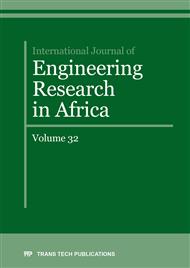[1]
E.N. Ali, S.A. Muyibi, H.M. Salleh, M.R.M. Salleh, and M.Z. Alam, Moringa oleifera seeds as natural coagulant for water treatment, Thirteenth International Water Technology Conference, (2009) 163-168.
DOI: 10.1109/icssbe.2012.6396541
Google Scholar
[2]
M. Yarahmadi, M. Hossieni, B. Bina, M.H. Mahmoudian, A. Naimabadie, and A. Shahsavani, Application of Moringa oleifera seed extract and polyaluminum chloride in water treatment, World Applied Sciences Journal, 7(8) (2009) 962-967.
Google Scholar
[3]
A.H. Kawo, and I.A. Daneji, Bacteriological and physcio-chemical evaluation of water treated with seed powder of Moringa oleifera lam, Bayero Journal of Pure and Applied Sciences, 4(2): (2011), 208-212.
DOI: 10.4314/bajopas.v4i2.42
Google Scholar
[4]
M. Awad, H. Wang, and F. Li, Preliminary study on combined use of Moringa seeds extract and PAC for water treatment research, Journal of Recent Sciences, 2(8) (2013) 52-55.
Google Scholar
[5]
D.N. Olowoyo, and A.O. Garuba, Adsorption of cadmium Ions using activated carbon prepared from coconut shell, Global Advanced Research Journal of Food Science and technology, 1(6) (2012) 81-84.
Google Scholar
[6]
B.Z. Shakhashiri, Water, Chemical of the week, (2011) 1-7. Available online at: www. scifun. org.
Google Scholar
[7]
P.H. Gleick, Dirty water: Estimated deaths from water-related diseases 2000-2020, Pacific Institute for Studies in Development, Environment, and Security, (2002), 1-12.
Google Scholar
[8]
E. Bernard, A. Jimoh, and J.O. Odigure, Heavy metals removal from industrial wastewater by activated carbon prepared from coconut shell, Research Journal of Chemical Sciences, 3(8) (2013) 3-9.
Google Scholar
[9]
C. Anyakora, K. Nwaeze, O. Awodele, C. Nwadike, M. Arbabi, and H. Coker, Concentrations of heavy metals in some pharmaceutical effluents in Lagos, Nigeria, Journal of Environmental Chemistry and Ecotoxicology, 3(2) (2011) 25-31.
Google Scholar
[10]
A.I. Babatunde, O.K. Abiola, O.A. Osideko, and O.T. Oyelola, Kinetic and equilibrium studies on the adsorption of Cu2+ and Zn2+ ions from aqueous solutions by bamboo root biomass, African Journal of Biotechnology, 8(14) (2009) 3364-3368.
Google Scholar
[11]
B.O. Opeolu, and O.S. Fatoki, Dynamics of zinc sorption from aqueous matrices using plantain (Musa sp. ) peel biomass, African Journal of Biotechnology, 11(68) (2012) 13194-13201.
DOI: 10.5897/ajb11.3725
Google Scholar
[12]
K. Ramakrishnan, and C. Namasivayam, Development and characteristics of activated carbons from jatropha husk, an agro industrial solid waste, by Chemical Activation Methods, J. Environ. Eng. Manage, 19(3) (2009) 173-178.
Google Scholar
[13]
F.F. Ojesola, Treatment of Water from Bore Hole Using Moringa oleifera Seed and Commercial Activated Carbon, Bachelor of Engineering Thesis, Afe Babalola University, Ado-Ekiti, Ekiti State, Nigeria, (2015) 68.
DOI: 10.59566/ijbs.2019.15104
Google Scholar
[14]
N.E. Nwaiwu, and A.A. Bello, Effect of Moringa oleifera-alum ratios on surface water treatment in North East Nigeria, Research Journal of Applied Sciences, Engineering and Technology, 3(6) (2011) 505-512.
Google Scholar
[15]
F.O. Okeola, and E.O. Odebunmi, Comparison of Freundlich and Langmuir isotherms for adsorption of methylene blue by agrowaste derived activated carbon, Advances in Environmental Biology, 4(3) (2010) 329-335.
Google Scholar
[16]
Y.B. Onundi, A.A. Mamun, M.F. Al Khatib, and Y.M. Ahmed, Adsorption of copper, nickel and lead ions from synthetic semiconductor industrial wastewater by palm shell activated carbon, International Journal of Environmental Science and Technology, 7(4) (2010).
DOI: 10.1007/bf03326184
Google Scholar
[17]
E.A. Oluyemi, A.F. Adeyemi, and I.O. Olabanji, Removal of Pb2+ and Cd2+ ions from wastewaters using palm kernel shell charcoal (PKSC), Research Journal in Engineering and Applied Sciences, 1(5) (2012) 308-313.
Google Scholar
[18]
E.C. Okoroigwe, A.C. Ofomatah, N.F. Oparaku, and G.O. Unachukwu, Production and evaluation of activated carbon from palm kernel shells (PKS) for economic and environmental sustainability, International Journal of Physical Sciences, 8(19) (2013).
DOI: 10.5897/ijps2013.3889
Google Scholar
[19]
A.A. Adeyi, L.T. Popoola, A.S. Yusuff, I.I. Olateju, and A.S. Grema, Kinetics analysis and dosage effects of manganese dioxide adsorbent on desulphurization of crude oil, Journal of Bioprocessing and Chemical Engineering, 2 (2014) 1-6.
Google Scholar
[20]
C. Song, S. Wu, M. Cheng, P. Pao, M. Shao, and G. Gao, Adsorption studies of coconut shell carbons prepared by KOH activation for removal of lead (II) from aqueous solutions, Sustainability, 6(1) (2014) 86-98.
DOI: 10.3390/su6010086
Google Scholar


